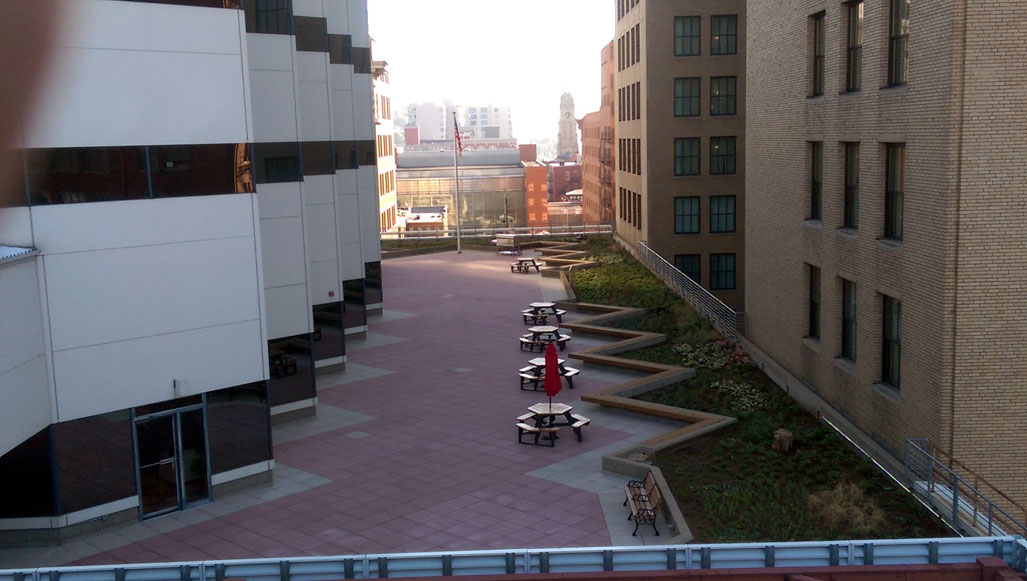Green roofs are an excellent tool in the green infrastructure toolbox. They don’t need extra space, they improve energy efficiency, and people like how they look. But while they are enjoying rapid growth in some parts of the world, America seems slower to adopt this technology. Maybe it’s the higher up-front cost, concerns about maintenance, or simple lack of awareness. Whatever the reason, today we’re going to talk about seven reasons you should love green roofs and consider them for your next project.
- Green roofs reduce heat – both inside and out.
Green roofs reflect the sun’s heat rather than absorbing it the way that asphalt shingles or commercial roofing surfaces do, and they act as a buffer for the building to reduce the urban heat island effect and cooling costs. The urban heat island effect refers to the way that city surfaces like glass, asphalt, and concrete reflect and radiate heat rather than diffusing it the way that plants and soil do. A city can be up to 5 degrees warmer than the surrounding areas during the day and 20 degrees warmer at night because of these heat-radiating and heat-reflecting surfaces. Green roofs can significantly reduce this effect (read more from the EPA). With a properly installed and insulated green roof, you can also see cooler temperatures inside in the summer. Exact energy savings are hard to determine, and they will vary from site to site, but they tend to be in the 5-20% range. - Green roofs last longer.
This one is news to a lot of people, but it may be one of the biggest factors in making green roofs a cost-effective building decision. A well-maintained green roof can last 40-50 years. In contrast, a conventional roof lasts about 20 years. And while maintaining a green roof may be more expensive than maintaining a conventional roof, the cost of maintenance doesn’t even come close to the cost of replacing your roof twice as often, and then you also have to factor in the energy savings we just discussed. - Green roofs capture rainwater.
In many major cities, storm water management is a serious public health and environmental problem. Many of our cities were built with one set of pipes for both sewage and storm water. But our populations have grown too large for our pipes, and cities were increasingly covered in impermeable pavement and building materials that can’t hold rainwater. This means that when we get heavy rains, the system overflows and dumps a mix of rainwater and raw sewage into our waterways. Green infrastructure systems are an excellent tool in storm water management, and green roofs are one of those options. The planting substrate and the plants themselves can absorb a significant amount of water before the excess runs out in gutters and into our sewer system. Some green roof systems even incorporate rainwater storage so that the captured water can be used for non-drinking purposes like irrigation and flushing toilets. - Green roofs capture carbon.
In addition to trapping rainwater, green roofs capture carbon in the air from cars, buses, planes, and any of the other countless number of carbon-emitting machines in a city. Plants use atmospheric carbon to build the sugars they need to grow, which can help mitigate carbon emissions in cities and overall contribute to a reduction in greenhouse gases. - Green roofs increase biodiversity.
The environmental benefits of green roofs just keep coming. A healthy green roof will attract bugs and birds that might otherwise have a hard time finding a place to thrive in the city. This is especially true for intensive green roofs which can host a wider range of plant life and therefore a wider range of other species. We go into more depth about the value of biodiversity in another blog post, but the short version is that biodiversity makes our environments more resilient to change. - Green roofs increase usable space.
Because of the fact that green roofs have a much cooler surface temperature than conventional roofs (up to 40-50 degrees cooler right next to the roof), installing a green roof also increases your usable space. You can add seating, leave spaces for gatherings, or incorporate walkways. Time spent outdoors can boost focus and productivity while decreasing stress and anxiety, so having a pleasant outdoor retreat right in your building can be a wonderful resource. (It is important to note that building planners need to be aware of a desire to use the roof as a people space so that the design and structure can be planned for safe and effective use.) - Green roofs provide pleasant views.
If your green roof is not on the top level of your building, or if you are in a taller neighboring building, you also get the benefit of a nice view. Looking at something green and vibrant is far more pleasant than an asphalt roof. But the benefits go deeper than just a fleeting nice feeling. Research indicates that even just looking at nature has measurable positive impacts on us. There’s even evidence that looking out a window with a view of nature reduces the length and discomfort of a post-operation hospital stay when compared to a view of only other buildings.
Want to learn more about the different types of green roofs and whether one might be a good fit for your home or business project? Stay tuned for future blog posts to learn more, and you can always contact us.
